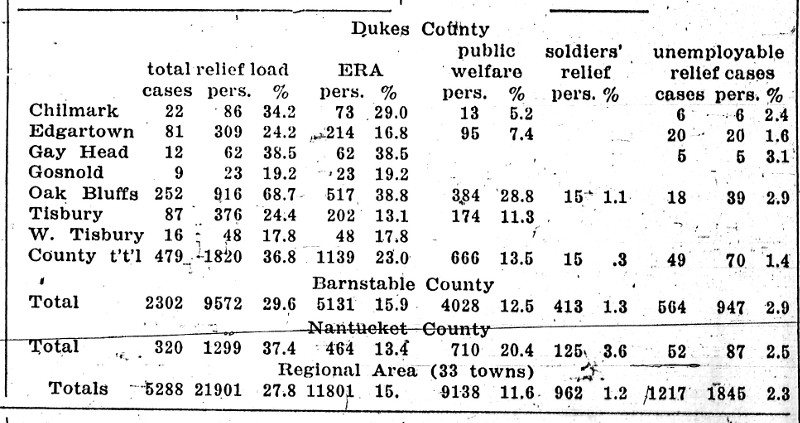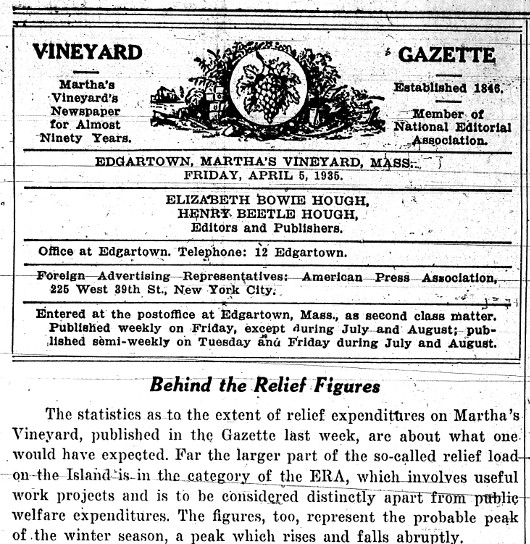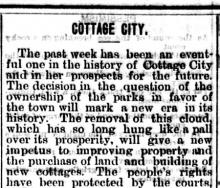A total of 36.8 per cent of the population of Dukes County, calculated on the 1930 census, is being supported by public funds either from the ERA, public welfare or soldiers’ relief, according to figures compiled by the Hyannis Regional ERA office for February.
For Dukes County, the accompanying table shows, the total relief load is 479 cases, supporting 1,820 persons. The number of persons is the total supported by men or women working on the ERA, public welfare, soldiers’ aid, or receiving direct aid as unemployable.
Oak Bluffs is the Vineyard town having the largest percentage of its population on relief, the figure being 68.7 per cent; West Tisbury has the smallest proportion, 17.8 per cent. As a matter of fact, the Oak Bluffs figure is the highest for any town in south eastern Massachusetts.
Uncle Sam is bearing the largest part of the relief burden in Dukes County, the table shows. No towns are contributing as much in public welfare and soldiers’ relief, as they receive in ERA funds. Gay Head, Gosnold and West Tisbury, save for a few unemployable relief cases in Gay Head, are supporting all needy cases through ERA employment and spent nothing on public welfare or soldiers’ relief in February.
Comparison of Percentages
The relief situation in Dukes compares favorably with that in Nantucket, where the percentage of the population supported by public funds is 37.4. Barnstable County has a figure of 29.6 per cent on relief; and the average for the thirty-three towns in southeastern Massachusetts is 27.8 per cent.
In the accompanying table, the number of “cases” is the number of men and women either working on the ERA, or receiving welfare or soldiers’ relief. The number under the columns headed “persons” means the total number of persons supported by such form of relief. A man who works on the ERA and who has three dependants would mean four persons on the ERA in this table.
All percentages are based on the 1930 census of population and indicate the proportion. Thus, as the table shows, 23 per cent of Dukes County residents are on the ERA, 13.5 per cent on welfare, .3 per cent on soldiers’ relief, 1.4 per cent receive welfare aid as unemployables; and the total relief load is 36.8 per cent of the population.
Both in Dukes and in Barnstable, the relief figures have been rising since October, and February marks the highest point. Relief authorities expect April to show the first decline.
Figures shown here are supplied by town officials to the Hyannis Regional ERA office, which administers ERA allotments in the 33 towns of this section. Robert F. Cross of Hyannis is regional administrator, and Frank G. Tarbox, field auditor, compiled these statistics.

From the April 5, 1935 edition of the Vineyard Gazette:
Editorial: Behind the Relief Figures
The statistics as to the extent of relief expenditures on Martha’s Vineyard, published in the Gazette last week, are about what one would have expected. Far the larger part of the so-called relief load on the Island is in the category of the ERA, which involves useful work projects and is to be considered distinctly apart from public welfare expenditures. The figures, too, represent the probable peak of the winter season, a peak which rises and falls abruptly.
The Island percentage of relief cases, using the term in the broad sense employed in present day discussions, is affected considerably by the high proportion in the town of Oak Bluffs. It is natural that Oak Bluffs should be hardest hit, for this is the one town of the Vineyard which, from the beginning, has rested upon summer resort business. A hundred years ago the site of the present Oak Bluffs was occupied for a week by a circle of nine crude tents, pitched for a camp meeting. In 1867 the development of the resort town began, and not until a decade later did the settlement begin to acquire a winter population. As summer activities increased, with the impetus of development companies and similar enterprises, the town grew and flourished; but it has never had an adequate diversity of occupation or industry to see it through the winter months.
Nowhere on the Vineyard has summer business yielded income enough to carry the residents through the winter without other means of livelihood. It is not desirable that this should be the case. In fact, an unfavorable effect of the post-war period of prosperity was that it tended to emphasize too much the income of summer and to minimize the importance of fisheries, agriculture and other productive enterprises.
The extent of the relief load today is a measure of several influences reflected in Island life: first, perhaps, the depressed returns from fisheries, aggravated, oddly enough, by such natural phenomena as the disappearance of eel grass from the coast; the producer, afloat and ashore, has always to contend with chances of nature as well as with chances of man-made economics; second, the failure of summer resort business to approach its old standards; and, third, the lapse of agriculture, due in part to general economic conditions over a long period, and in part to a more or less conscious turning away from agriculture by Vineyarders.
It would be unfortunate if the Island should make no effort to analyze the relief situation today and the circumstances which the figures imply. We need to plan a better orientation, and this must be both an individual and a community problem.












Comments